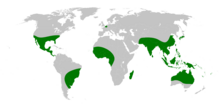Crossopriza lyoni
| Tailed cellar spider | |
|---|---|
 |
|
| Crossopriza lyoni | |
| Scientific classification | |
| Kingdom: | Animalia |
| Phylum: | Arthropoda |
| Subphylum: | Chelicerata |
| Class: | Arachnida |
| Order: | Araneae |
| Infraorder: | Araneomorphae |
| Family: | Pholcidae |
| Genus: | Crossopriza |
| Species: | C. lyoni |
| Binomial name | |
|
Crossopriza lyoni (Blackwall, 1867) |
|
 |
|
| C. lyoni estimated distribution. | |
| Synonyms | |
|
Species synonymy
|
|
Crossopriza lyoni is a widespread species of cellar spiders that prefer to live in or around human structures. They are commonly known as tailed cellar spiders, tailed daddy longlegs spiders, and sometimes box spiders. They all possess extremely long fragile legs that can reach up to 6 cm (2.4 in) long and a body length of that ranges from 2.5 to 7 mm (0.098 to 0.276 in). Their abdomens are distinctly squarish when viewed from the side and their carapace is more or less circular when viewed from above. They also possess two kinds of sound-producing organs and have six eyes.
The original range of C. lyoni is unknown. They have been introduced into other parts of the world accidentally and are now pantropical in distribution. They are a regulated species in some countries and are often regarded as pests due to the large amounts of unsightly webs they construct inside human homes. Some people, however, regard them as beneficial, as they are efficient predators of mosquitoes and other arthropods. They are harmless to humans.
Crossopriza lyoni are classified under the genus Crossopriza and the subfamily Holocneminae. They belong to the cellar spider family (Pholcidae). They are commonly referred to as tailed daddy longlegs spiders, tailed cellar spiders, or (more rarely) box spiders. C. lyoni and other cellar spiders are also often confused with two other invertebrates - the harvestmen (order Opiliones) and the crane flies (family Tipulidae) - both of which are also known as 'daddy longlegs'. However, they are not closely related to cellar spiders — the latter is a fly; and the former, while also an arachnid, is not a spider at all.
...
Wikipedia
